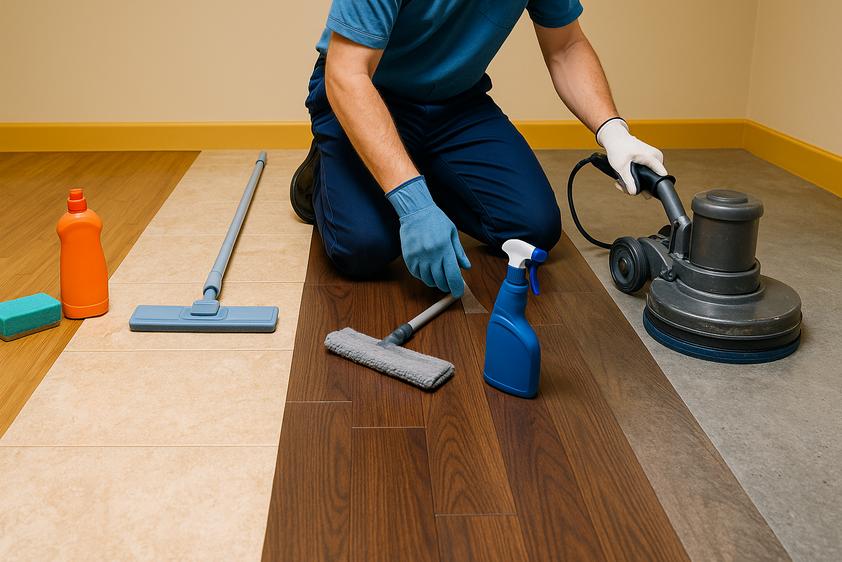Bamboo Isn’t Just a Fancy Stick
Bamboo flooring has the laid-back vibe of sustainability, but don’t be fooled. It’s grass, not wood, and that changes everything. While it looks like your average plank, it reacts to moisture like a moody cat: unpredictably and with a tendency to overreact.Too much water during cleaning? Expect swelling. Use a steam mop? Great—if you’re hoping to warp it like a cheap pizza tray. Bamboo needs a soft-touch approach, and ideally, cleaners with a pH-neutral profile. And when scratches or dulling become noticeable, that’s your cue to bring in a pro who understands strand-weaving, carbonization, and how not to wreck your ethically sourced pride and joy.
Travertine: Beautiful, Porous, and Probably Already Stained
Travertine is what happens when stone tries to be soft. Sure, it looks high-end, but it absorbs spills faster than a gossip absorbs secrets. Its natural holes and pits are charming, right until red wine enters the chat. And standard tile cleaner? That’s an acid party waiting to eat through your floor’s face.This isn’t a material for shortcuts. It needs sealing, specific cleaners (absolutely no vinegar), and an experienced hand for restoration. Professionals know how to clean it without stripping away its finish or grinding down its natural texture. If you’ve got etching, pitting, or ghost stains that won’t leave, it’s not your mop’s fault—it’s time to call someone with stone credentials.
Engineered Hardwood: Not a “One-Size-Fits-Windex” Surface
Engineered hardwood has become the darling of modern renovations: looks like hardwood, resists moisture better, and keeps your budget from sobbing. But here’s where it gets tricky—people hear “engineered” and assume it’s invincible. It’s not. Under that thin layer of real wood is plywood, and beneath your assumptions might be irreversible damage.Swamping it with water? Big mistake. Harsh chemicals? Those can break down the finish or cause the veneer to lift. Even some microfiber mops are too aggressive if used with the wrong cleaning solution. The top layer is usually too thin to refinish more than once—if at all. Professionals know how to clean it without shaving years off its life. They’ll use specialized tools and low-moisture techniques that keep the structure intact while reviving the finish.
Polished Concrete: It’s Not Just a Garage Thing Anymore
Polished concrete has gone from “warehouse aesthetic” to high-end home darling, and it’s not hard to see why. Sleek, industrial, and impossible to stain—well, until you forget that concrete is actually one giant sponge with a nice finish on top.Yes, it’s tough—but it’s also absorbent, and that polished layer is more delicate than it looks. Using acidic cleaners or overly abrasive pads can ruin the shine and make it look chalky. Over time, grime builds up in tiny surface pores, creating a haze that no household mop can remove.
That’s when a floor technician with diamond polishing pads and the right sealing compound becomes your best friend. These pros can re-buff, re-seal, and restore the shine without turning your modern floor into a matte memory.
General Advice Is Like a Universal Remote—It Mostly Doesn’t Work
Most floor cleaning advice assumes your home is filled with indestructible laminate. You’ll hear things like “just use vinegar and water” or “steam cleaning works for everything.” That’s great—if your goal is to void warranties and slowly sabotage your flooring investments.The truth is, cleaning techniques need to match the floor’s material, finish, porosity, and even how it was installed. What works beautifully on glazed tile might wreck unsealed concrete. What makes engineered wood look shiny could leave hardwood with streaks or buildup. If you’re mixing your own potions from blog advice, there’s a non-zero chance you’re quietly wrecking something that cost thousands to install.
Professional cleaners don’t just bring heavy equipment—they bring knowledge. They know the difference between a polyurethane seal and a penetrating oil finish. They can identify resin-coated stone versus honed marble. And more importantly, they know when to leave a floor alone and when to go all in on restoration. That kind of judgment doesn’t come in a spray bottle.
You Don’t Know What You Don’t Know—But They Do
Ever tried buffing out a scratch only to make it worse? Or maybe you spot a mystery stain that reappears like a horror movie villain, no matter how many times you mop it? Floors have quirks. Some hold moisture deep below the surface. Others react to oils in a cleaner. Many have protective coatings that degrade invisibly over time.This is where professionals earn their keep. They can spot subtle signs of wear you’d overlook—like early finish breakdown, trapped moisture, or micro-abrasions from grit. They have access to tools and products that aren’t sitting in the grocery store aisle next to the budget dish soap. And when they’re done, your floor won’t just be clean—it’ll be correctly maintained.
Floor Me Once, Shame on You
If your floor is more than a basic laminate job, there’s a good chance it needs occasional professional care—whether that’s deep cleaning, sealing, or just a checkup from someone who knows what they’re doing. DIY has its place, but assuming every floor wants the same mop-and-bucket routine is like assuming every car runs fine on vegetable oil. Some will. Most won’t. And a few will explode metaphorically—usually the expensive ones.So yes, mop your floors. Care for them well. But if you’ve invested in something a little more special—travertine, bamboo, engineered wood, polished concrete—don’t cheap out on maintenance. Call someone who can give your floors the treatment they actually deserve. Not just a clean, but the right clean.
Article kindly provided by dabcleaning.co.uk


